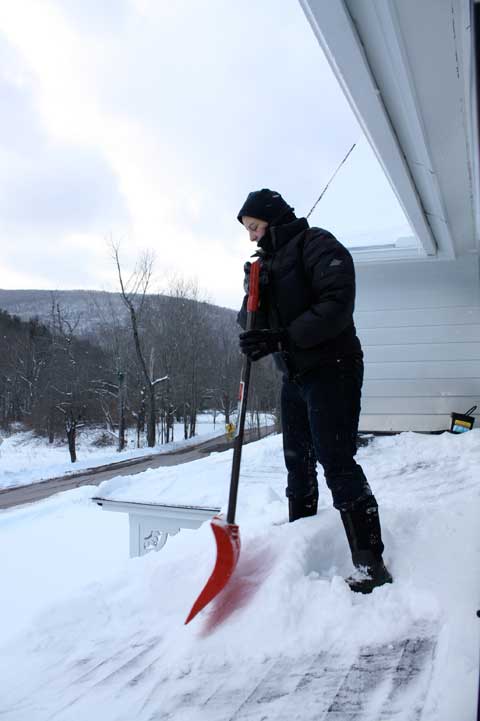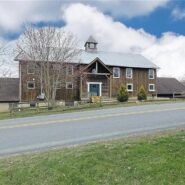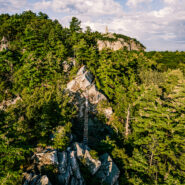The Weekenders: Winter = Ice Dams
Kim McGalliard | January 11, 2013
One of the things I’ve mentioned several times here is how we often have a lot of projects and plans for what we’re going to do with the house, much of which we don’t get done because we’re only there on weekends. There just isn’t enough time to get everything done. I wrote a few months ago about some winterizing we were planning on doing to the house (much of which we didn’t actually get done) and the dilemma we were having about insulating the attic. At the time, the attic insulation issue was conceptual – it was about energy savings and doing the right thing for the house. But now that it is actually (and seemingly very suddenly) winter, and we got 18” of snow over the holidays, the lack of insulation and ventilation in our attic is no longer conceptual: it’s real and the reality is ice dams.
What are ice dams? Ice dams happen when you get snow on your roof, then it melts and refreezes and melts and refreezes on the main surface of your roof, but not along the eaves and edges where it normally drips off. This causes a big ridge of ice to form all along the edge of your roof making it so any more snow melting can’t escape. Although you sometimes get them when you don’t have gutters, gutters make them worse because your gutters fill up with ice, then there is nowhere for the melting snow to go, so it just freezes on top of all of the ice in your gutter making the problem worse. Last year, we didn’t have gutters, and we didn’t have that much snow, so we didn’t have this problem. We got gutters this fall (which have helped the moisture issue in our basement a lot) and we’ve gotten snow, so this year we have ice dams.
Why are ice dams a problem? Well, for one thing, when the ice gets really heavy, it can tear off your gutters. I think we have a guarantee of some sort with the company that put in ours and they will come reattach them if they come off, but still, it would be a drag if they did. The biggest issue is that if the ice dams get really bad, the melting water, with nowhere to go, will go UP and UNDER your roof shingles and down into the interior of your house – down your walls and ceilings. This is a bad thing.
The funny thing is that I mostly felt we were pretty prepared for winter. We got our delivery of firewood at the end of the summer from Mountain Valley Fuel & Wood Recycling (John’s a super nice guy with really good wood. We highly recommend him) . We arranged with our neighbor to plow our driveway. We got a new snow shovel and our shiny new boiler had been installed. We’d heard about the horrors of ice dams before, but I kind of forgot about it so we were totally unprepared.
So now that we have them we had to figure out how to fix them before they caused any damage. There are, of course, several different ways, theoretically, to deal with them.
Get a snow rake and remove the snow at least three feet from the edge of your roof. The theory here is that if the snow along the eave is removed, the ice won’t build up. The problem is that the edge of the roof isn’t always reachable (even with a long rake) and if you aren’t at your home all of the time, as many weekenders aren’t, you will need to get (pay) someone to do it for you.
There are multiple electrical heating products available that you can install in your gutter and along your roof edge. These use electricity to heat cables to melt the ice on your roof edge and inside your gutter. Our neighbor bought Easy Heat, but hasn’t installed it yet (he was using a propane torch to melt channels in the ice to get it to drain better when we talked to him this weekend). These definitely seem like a good permanent solution, but they require electrical outlets be installed under your eave to plug them in, and once they are on your roof, you don’t remove them – they stay there year-round. And you have to install them BEFORE you get ice dams, not after.
You can also call a roofer or specialized ice dam removal company to come out and remove the ice dam with steam.
Our solution – or our solution for now: Pantyhose. Seriously. We got this tip from This Old House (which we now read religiously). The idea is that you need to create vertical channels perpendicular to your gutter for the water to escape. So, you get some knee-high panty hose (we chose the L’egss brand, though unfortunately they don’t come in the silver plastic eggs anymore). We put a flat rock in the toe end, filled the stocking with Calcium Chloride, tied the end, then gently tossed them up on the roof, perpendicular to the gutters, with the salty end in the gutter. Over the next day, the salt-filled panty hose, looking like flesh-colored salami, melted a through the snow down to the shingles of the roof, creating channels for the water to drain from the roof. We’ll know more how it worked when we go back on Friday night. My main concern is what all of that salt is going to do to my yard and the plants around then house when it drips off.
We are definitely not the only people to do this.
Hopefully this will help us get through this winter, but over the long term, we need to do further insulation and ventilation work in the attic to hopefully keep it from happening again.
Anybody else have any great ice dam removal or avoidance tips?
Read On, Reader...
-

Jane Anderson | April 1, 2024 | Comment A Westtown Barn Home with Stained-Glass Accents: $799.9K
-

Jane Anderson | March 25, 2024 | Comment A c.1920 Three-Bedroom in Newburgh: $305K
-

-

Jaime Stathis | February 15, 2024 | Comment The Hudson Valley’s First Via Ferrata at Mohonk Mountain House
